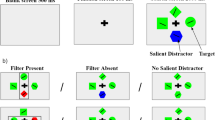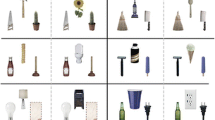Summary
Using compound letter stimuli (Navon, 1977), Paquet and Merikle (1988) found that subjects are very good at ignoring distractor letters shown in an irrelevant location when the distractors are also shown at the level of the structure opposite to that of the target. However, the procedure used by Paquet and Merikle (1988) might have biassed the results toward showing relatively poor non-target processing in this instance. The target level of structure was a blocked variable, and so subjects could ignore the other level of structure completely. In the present experiment, the target level was either blocked, requiring focussed attention to one level of structure, or else it varied randomly from trial to trial. This latter condition should require attention to be allocated to both levels of structure. Results were the same in both cases, namely efficient filtering of nontarget information when it was not at the target level of structure. The results are related to proposals (Duncan, 1981; Van der Heijden, 1981) that semantic analysis of visual information is an unlimited-capacity process.
Similar content being viewed by others
References
Briand, K. A. (submitted). Selective attention to global and local structure of objects: The role of cuing dimension.
Duncan, J. (1981). Directing attention in the visual field. Perception & Psychophysics, 30, 90–93.
Johnston, W. A., & Heinz, S. P. (1978). Flexibility and capacity demands of attention. Journal of Experimental Psychology: General, 107, 420–435.
Johnston, W. A., & Heinz, S. P. (1979). Depth of nontarget processing in an attention task. Journal of Experimental Psychology: Human Perception and Performance, 5, 168–175.
Kahneman, D., & Henik, A. (1981). Perceptual organization and attention. In M. Kubovy & J. R. Pomerantz (Eds.), Perceptual organization (pp. 191–211). Hillsdale, NJ: Erlbaum.
Navon, D. (1977). Forests before trees: The precedence of global features in visual perception. Cognitive Psychology, 9, 353–383.
Paquet, L. (1988). L'Attention selective: L'Effet du critère de sélection. L'Année Psychologique, 88, 179–195
Paquet, L., & Merikle, P. M. (1988). Global precedence in attended and nonattended objects. Journal of Experimental Psychology: Human Perception and Performance, 14, 89–100.
Van der Heijden, A. H. C. (1981). Short-term visual information forgetting. London: Routledge & Kegan Paul.
Van der Heijden, A. H. C., Hagenaar, R., & Bloem, W. (1984). Two stages in postcategorical filtering and selection. Memory & Cognition, 12, 458–469.
Author information
Authors and Affiliations
Rights and permissions
About this article
Cite this article
Briand, K.A. Efficient filtering of irrelevant global and local information when target level and location are random. Psychol. Res 55, 264–269 (1993). https://doi.org/10.1007/BF00419686
Received:
Accepted:
Issue Date:
DOI: https://doi.org/10.1007/BF00419686




